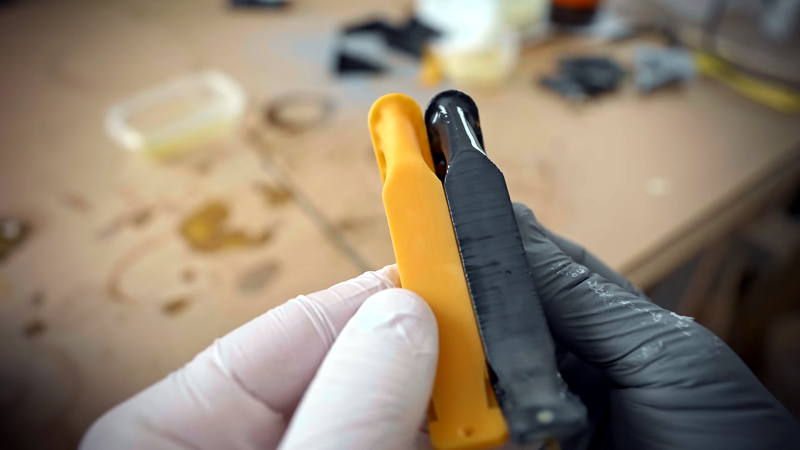[Thomas Sanladerer] has a filament-based 3D printer and a resin one. Can the two types of raw material combine to make something better? [Thomas] did some experiments using some magnets to suspend the parts and a hot air soldering gun to heat things up.
The trick turns out to be cutting the resin with alcohol. Of course, you also need to use a UV light for curing.
The parts looked pretty good, although he did get different results depending on a few factors. To see how it would work on a practical part, he took a very large printed alien egg. The problem is, the egg won’t fit in the curing station. A few minutes with a heat sink, a drill press, and an LED module was all it took to build a handheld UV curing light.
The good news is you don’t need a resin printer to take advantage of the process — just the resin. He also points out that if you had parts which needed to maintain their dimensions because they mate with something else, you could easily mask the part to keep the resin away from those areas.
If this video (and the results it shows) has you interested, then you’ll love the in-depth account that [Donald Papp] wrote up last year about his own attempts to smooth 3D printed parts with UV resin.
















So almost plating the print with resin cool.
I actually had to watch the video to understand the article. You thin down the resin by mixing 1 part resin with 2 parts alcohol, then cover the FDM print with the mixture, let alcohol evaporate, then cure with UV light. The magnets and hot air gun are not relevant.
Is your aim in life to archive the number of comments to each post?
One point to make, not on point – that appears to be waaay too much thermal compound used between the UV LED driver and the heatsink. The idea should be just to fill in the tiny, microscopic cracks in the mating surfaces. These will retain air and air is a pretty good thermal isolator when static. Thermal paste itself is also a fair thermal isolator but conducts heat better than static air. You want the most metal-metal contact, between the devices, that you can get. Which is why fine sanding and lapping even, helps. Thermal paste should be applied and then scrapped off, leaving only the cracks filled.
Please watch these. In short, it doesn’t really matter:
https://youtu.be/EUWVVTY63hc?t=731
https://youtu.be/r2MEAnZ3swQ?t=464
it doesnt matter, excess sqishes out the sides leaving you knowing you filled in all those tiny microscopic inperfections
So you watched a youtube video and are now trying to capitalize on his work?
Welcome to Hackaday! We’ve been capitalizing on the work of others for fifteen years now, and you can too.
The title of this article talks about SLS resin, while the article itself is about SLA resin.
SLS and SLA are different 3D printing processes. SLS (selective laser sintering) uses Nylon microparticles as a printing medium. It’d be cool to see an FDM print finished with SLS resin particles, but this ain’t it.
I wonder if it’s possible to create a PLA dust suspended in water(With a binder?), then paint it onto a print and thermally sinter it.
I’ve been using an ABS slurry to post process prints.. this makes me think there might be interest in a write-up on that!
Slurry for smoothing? I’d love to see what you’ve found.
SLA not SLS, two different technologies and ones a thermoplastic the other thermoset. Most 405nm curable resins work well for this with low intensity UV.
He never investigated leaving the 2:1 thinned down resin to dry long enough to fully evaporate the IPA. Also, pooling of the solution was allowed which could have been eliminated or reduced by submitting the dipped parts to shock.
I hope he does a strength analysis of dipped parts at some point in the future.
same here, sometimes using some “ABS milk” (about same texture / thickness or just little thicker tnan milk ) to smooth out some pla prints. one coat or more . can act like a “primer” too to make layers lines fade out before a paint job. cheaper than the resin solution : just add abs leftovers in some acetone and you are good to go.
Is there a video or write up of examples that you’ve found? I’d like to see more!
Might be worthwhile just using regular UV-cured resins rather than those sold for SLA printers (that need to deal with all the fancy oxygen inhibition properties that allow the prints to layer well) to save cost.